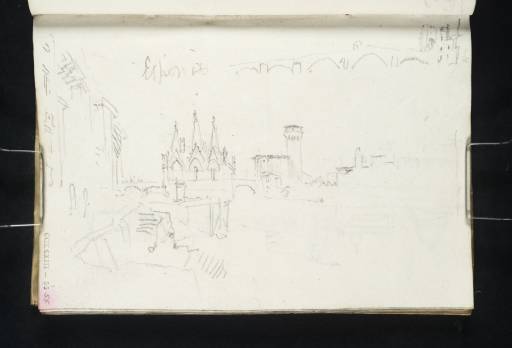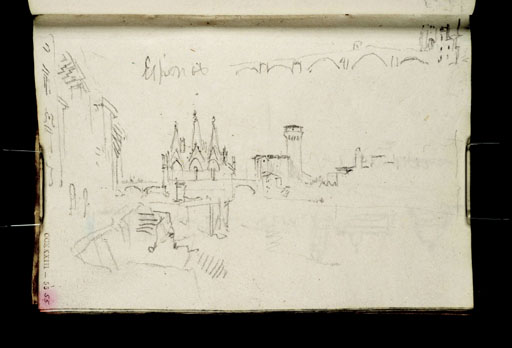Joseph Mallord William Turner The Santa Maria della Spina and Torre Guelfa, Pisa 1828
Image 1 of 2
Joseph Mallord William Turner,
The Santa Maria della Spina and Torre Guelfa, Pisa
1828
Folio 55 Recto:
The Santa Maria della Spina and Torre Guelfa, Pisa 1828
D21519
Turner Bequest CCXXXIII 55
Turner Bequest CCXXXIII 55
Pencil on white lined wove paper, 96 x 144 mm
Inscribed in pencil by Turner ‘Espina’ towards top left
Inscribed in red ink ‘55’ (smudged), overwritten in pencil by C.F. Bell ‘55’, bottom left, descending vertically
Stamped in black ‘CCXXXIII – 55’ bottom left, descending vertically
Inscribed in pencil by Turner ‘Espina’ towards top left
Inscribed in red ink ‘55’ (smudged), overwritten in pencil by C.F. Bell ‘55’, bottom left, descending vertically
Stamped in black ‘CCXXXIII – 55’ bottom left, descending vertically
Accepted by the nation as part of the Turner Bequest 1856
Exhibition history
1992
Turner and Byron, Tate Gallery, London, June–September 1992 (61, reproduced).
References
1909
A.J. Finberg, A Complete Inventory of the Drawings of the Turner Bequest, London 1909, vol.II, p.716, CCXXXIII 55, as ‘Town, with bridge. Probably Pisa’.
1968
Luke Herrmann, Ruskin and Turner: A Study of Ruskin as a Collector of Turner, Based on his Gifts to the University of Oxford; Incorporating a Catalogue Raisonné of the Turner Drawings in the Ashmolean Museum, London 1968, p.80 under no.52.
1974
Anthony Burton and John Murdoch, Byron: An Exhibition to Commemorate the 150th Anniversary of his Death in the Greek War of Liberation, exhibition catalogue, Victoria and Albert Museum, London 1974, p.132 under no.S35.
1975
Luke Herrmann, Turner: Paintings, Watercolours, Prints & Drawings, London 1975, p.323 under nos.111, 112.
1979
Andrew Wilton, J.M.W. Turner: His Life and Work, Fribourg 1979, pp.445–6 under no.1219.
1984
Cecilia Powell, ‘Turner on Classic Ground: His Visits to Central and Southern Italy and Related Paintings and Drawings’, unpublished Ph.D thesis, Courtauld Institute of Art, University of London 1984, pp.301 note 19, 434.
1987
Cecilia Powell, Turner in the South: Rome, Naples, Florence, New Haven and London 1987, pp.[139], 206 note 14.
1992
David Blayney Brown, Turner and Byron, exhibition catalogue, Tate Gallery, London 1992, p.107 no.61, reproduced as ‘Santa Maria della Spina on the River Arno’.
1993
Jan Piggott, Turner’s Vignettes, exhibition catalogue, Tate Gallery, London 1993, pp.44, 70 note 57.
Dominating this west-facing view is a detailed rendering of the eastern façade of the Church of Santa Maria della Spina, located on the south bank of the River Arno in Pisa. It is labelled above with the artist’s inscription ‘Espina’. Built in the Gothic style, this small medieval church was named after the reliquary it once housed, ‘spina’ meaning thorn. In 1871, decades after Turner’s visit, the perpetual risk of flood damage prompted the decision to completely dismantle and reassemble the building at a high level on the embankment, where it still stands today. On examining the reconstructed church, John Ruskin reportedly criticised the project’s poor execution.1
In around 1832, Turner executed the watercolour vignette Santa Maria della Spina, Pisa (Ashmolean Museum, Oxford; WA1861.12), which later entered the collection of John Ruskin.2 The vignette was originally commissioned and engraved to illustrate The Works of Lord Byron, published by John Murray between 1832–3 and edited by Thomas Moore, who also contributed a biography of the poet (Tate impression: T06182).3 The vignette featured as the frontispiece to the fifth volume, illustrating a section on Byron’s stay in Pisa in 1821–2, a few years before Turner’s visit in 1828.4 Byron lived in the Casa Lanfranchi on the opposite bank.5 While Turner’s watercolour was reportedly based on a sketch by the artist William Page (1794–1872), it shares compositional features with the present sketch, the key difference being the addition of numerous boats in the watercolour version, as noted by Luke Herrmann.6 As David Blayney Brown observed, Turner’s watercolour ‘throws the picturesque Gothic spires of Sta Maria into high relief’, a feature similarly apparent in the present sketch.7
Visible beyond the church is the Ponte della Cittadella; the version shown here is the original twelfth-century stone bridge, which collapsed due to flooding in 1869. Its iron replacement was destroyed during the Second World War and replaced once more with the current concrete and stone version. The same view now features another bridge, the Ponte Solferino, which lies between the Ponte della Cittadella and the Santa Maria della Spina. The tower to the right, on the north bank of the Arno, is the Torre Guelfa, a defensive structure built in the early fifteenth century. The minor sketch across the top of the page offers an unobstructed view of the Ponte della Cittadella. The Torre Guelfa in the top-right corner spills over onto folio 54 verso opposite (D21518).
See under folio 31 recto (D21472) for a general commentary on Turner’s visit to Pisa, together with a list of relevant works in the sketchbook.
Hannah Kaspar
November 2024
‘Church of Santa Maria della Spina’, Comune di Pisa – Turismo, accessed 2 May 2024, https://www.turismo.pisa.it/en/place/church-of-santa-maria-della-spina .
How to cite
Hannah Kaspar, ‘The Santa Maria della Spina and Torre Guelfa, Pisa 1828’, catalogue entry, November 2024, in David Blayney Brown (ed.), J.M.W. Turner: Sketchbooks, Drawings and Watercolours, Tate Research Publication, February 2025, https://www


